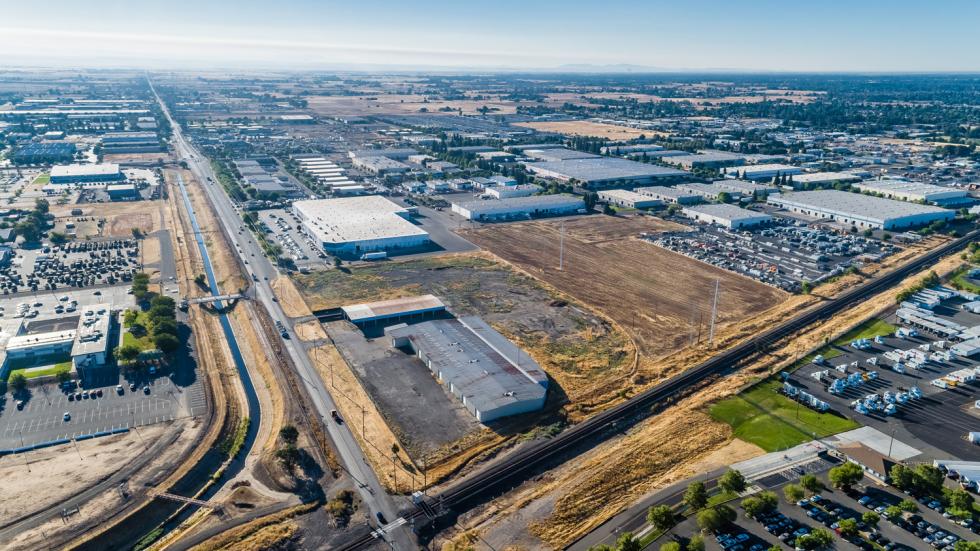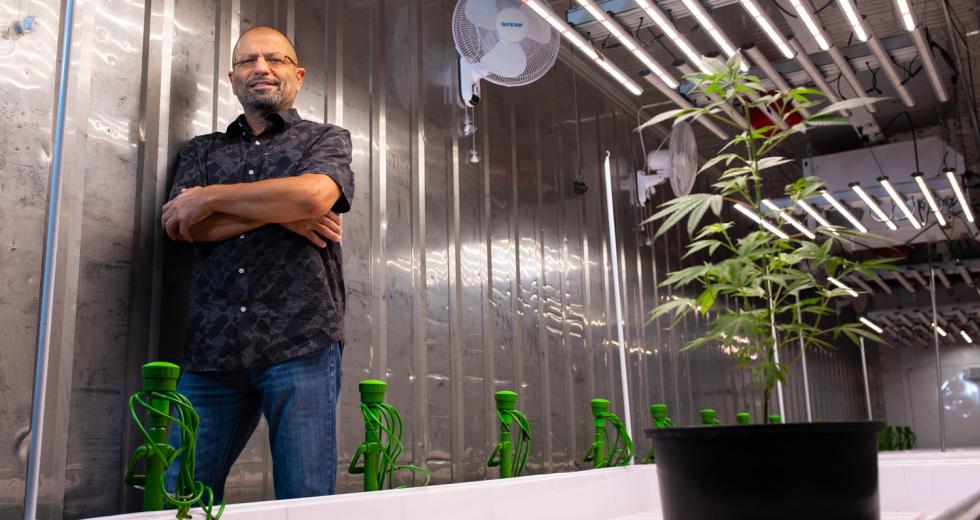When the City of Sacramento first approved commercial cannabis activities — beginning with recreational cultivation ordinances in November 2016 — the municipality was attempting to get ahead of operators with a proactive, regulatory framework. Now Sacramento is one of the few jurisdictions in the Capital Region to move forward with regulations for the cultivation, manufacturing, distribution, retail and testing laboratories of commercial cannabis.
With Sacramento quickly becoming a base of operations for commercial cannabis, the disruption in the industrial real-estate market has been significant. Entrepreneurs looking to enter the space have flocked to approved zoning areas primarily clustered in North Sacramento and the Power Inn neighborhoods with existing concentrations of industrial, heavy commercial and light warehouse facilities.
That’s sparked an industrial-property frenzy that is driving up real-estate prices, displacing other commercial tenants and creating undue concentration in some neighborhoods. Property values for commercial space in approved cannabis “green zones” are roughly double the cost before legalization, with rents four or five times the norm. Meanwhile, non-cannabis businesses competing for similar spaces have become casualties in the chaos.
Related: The Herb Column: Where Did All the Cannabis Watchdogs Go?
Related: Joe Devlin on how the city is adopting legal cannabis
Related: Cannabis Can Go From Conundrum to Catalyst
“When you take a step back and look at the totality of the state of California, you recognize that there are a few hundred blocks of commercial real estate, more or less, in this state that you can currently operate in,” says Daniel Conway, managing partner of Truth Enterprises, an investment firm in Sacramento focused on the legal weed industry. “So that alone creates artificial demand that inflates prices.”
The expense of getting commercial cannabis spaces and businesses up to regulatory code can be crippling, pushing out smaller and less-experienced operators. But some savvy entrepreneurs say they have found a foothold by integrating multiple aspects of the supply chain — either under the umbrella of one business, one space or both.
With so much ambiguity in the cannabis space, and so much change expected in the coming months as the regulated market gets on its feet, these entrepreneurs are leaning on past knowledge and experience, and a sophisticated approach to get out in front of the ever-changing market.
We Grow CA is on track to open Sacramento’s first cannabis campus
— the highlighted area outlines its 250,000 square feet of space
located on Elder Creek Road in the Power Inn district. photo: eli
margetich, rendering: courtesy of we grow ca

REAL-ESTATE CRUNCH
Of California’s 482 municipalities and 58 counties, fewer than one-third of California cities allow any kind of cannabis business to operate within their borders, and approximately 70 percent of counties have outright banned commercial cannabis in any form in unincorporated areas.
“If I could describe the city’s approach to cannabis, it’s been one of pragmatism,” says Joe Devlin, Sacramento’s inaugural chief of cannabis policy and enforcement. “There was a cannabis community before we started regulating, and the approach/belief was that the best way to make sure it’s safe for our consumers was to make sure that it was regulated.”
With so many cannabis entrepreneurs converging on Sacramento, a commercial property in the City’s approved green zones that includes ample power (the average commercial grow facility uses 60-80 watts of electricity per square foot, to an average facility’s 5-10 watts), and proper setbacks (including a 600-foot buffer from schools and parks) could command an additional $20-$30 per square foot above the already inflated prices, says Jay Richter, vice president with Sacramento’s Kidder Mathews. If the property already has a conditional use permit (CUP), it could fetch an added premium of up to $200 per square foot.
The high demand for conforming green-zone properties means high demand overall, driving up the value of nonconforming properties as well. That’s a real problem for other commercial tenants who are being priced out of the market.
Tracey Schaal is the executive director for the Power Inn Alliance, which represents 11,000 property owners in southeast Sacramento. The Power Inn area has drawn the largest concentration of commercial cannabis operators primarily because of its abundance of industrial space, central location, strong transportation access and a cost-effective electrical provider in SMUD.
Prior to the cannabis real-estate boom, the Power Inn district had a vacancy rate of 8 percent. That’s now plunged to 2 percent, which Schaal says is unhealthy for an industrial area and is displacing non-cannabis businesses. “Other industries either can’t find space, or if they can, they can’t afford it,” she says. “Diversity is the key to any successful economy, so we don’t want existing businesses to be displaced, and this is happening all over the district.”
Danny Deane has run a furniture manufacturing business in the Power Inn district for five years, but is now being pushed out. “There is nothing available at a reasonable cost for someone like me in manufacturing,” he says. “We can’t afford to pay rates like this to stay in California.” Deane must now balance the cost of a move and replacing his current workforce (he’s considering relocating to Reno), with the long-term costs of staying. “It’s a very difficult decision for me to make.”
“You probably can’t do anything terribly significant in this space for less than seven figures.” Daniel Conway, managing partner, Truth Enterprises
The district’s concentration of cannabis prompted the Power Inn Alliance to request a cap from the City of Sacramento on the number of cannabis businesses allowed to operate within its borders. In May, the Sacramento City Council voted to cap cannabis businesses at 10 percent of the total industry in the Power Inn area, or 2.5 million square feet. The City currently has CUP requests for 2.8 million-square-feet in the district.
“The Alliance wants to be open to new businesses, while ensuring we maintain the ability to keep our economic base,” Schaal says (which is primarily in manufacturing), noting the organization is agnostic on the product. “My job is to oversee the overall vitality of the district.”
Once the cap was approved, Deane’s landlord reached out to negotiate, proposing a five-year lease at 40 cents per square foot — double Deane’s current rate. “I’m not willing to sign a five-year lease at inflated prices because I think the market will come back down in two years,” he says. “Not all these cannabis startups are going to make it, which means a lot of vacant buildings and lower prices.”
BARRIERS TO ENTRY
Nasser Azimi, of Ohana Gardens, uses shipping containers for his
grow spaces, which helps prevent potential cross-contamination in
his plants from mold, mildew and bugs.

The cost to break into the cannabis business is excessive, especially for new operators. The City of Sacramento charges about $30,000 for a CUP (which stays with the property). The average cost for a business operating permit (which stays with the business) is $10,000-$22,000, but can go as high as $30,000 — and separate permits are required for each point in the supply chain. Add to that the additional excise and cultivation taxes, and the barrier to entry becomes significant. Conway estimates the minimum investment to get into the cannabis space is $2 million: “You probably can’t do anything terribly significant in this space for less than seven figures.”
Compounding the problem, some brokers use misleading tactics to capitalize on the confusion of the cannabis market. “I see it all of the time,” says Richter. “A broker lists a property that states that it’s in the green zone, and it doesn’t fit or qualify to be utilized as a cannabis property because it does not meet all of the setbacks or there’s not enough power allocated to the area to make it a viable green property.”
Nasser Azimi, who has a background in local government and the high-tech software industry, is a small cannabis operator and co-owner with son Dar of the Ohana Gardens Collective in Sacramento. Frustrated by what he calls predatory practices by some commercial property brokers, the company eschews traditional commercial facilities in favor of souped-up, modular shipping containers for its grow spaces that are discreetly tucked away inside nondescript industrial warehouses. Individual containers are easier to make compliant with odor and security requirements, Azimi says. The build out also costs less, the grow rooms are portable and having multiple contained spaces limits cross-contamination from common cannabis concerns like mold, mildew and bugs.
Each grow chamber — which includes roughly 500 square feet of plants in 8-foot-wide containers that vary in length from 10 to 40 feet — is automated for water, temperature, lighting and security. “We have heavy technology integration. We did that for operational efficiency, but also to increase transparency,” says Azimi, who routinely gives tours of Ohana’s facilities to regulatory officials. The vertically integrated operation covers a total of 22,000 square feet across multiple locations and cities and includes cultivation, manufacturing, distribution and a high-tech delivery system that attempts to combine an Amazon-style point-of-sale experience with an Uber-like delivery structure.
Ohana originally started in 2014 as a medical marijuana business that was self-funded by the entrepreneurs. Following the passage of California’s Proposition 64, which legalized the adult use of recreational marijuana in November 2016, the company added recreational cannabis. The business has expanded its grow operations outside Sacramento to San Diego and Long Beach, and has landed its first retail facility in Emeryville. The company plans to significantly expand its retail operations. While Sacramento is currently not permitting additional facilities, Azimi has storefront operations in the queue for San Diego, Long Beach, San Bernardino, Hayward, Modesto, West Hollywood and Santa Monica.
“Right now we are small but growing organically across the state,” Azimi says. “We do a considerable amount of customer retention, which is how we keep up with the big boys. And we do it smart, in an efficient fashion with an extensive amount of research and technology integration.”
UNDER ONE ROOF
Launched in December 2016, Sacramento-based We Grow CA began as a real-estate property management company specializing in leasing and developing commercial cannabis space. Co-founders Guy Matalon, Ori Bytton and Barry Shy — entrepreneurs with years of industry-related experience in commercial sales, real estate and solar technology — originally hailed from Israel. Matalon and Bytton have been in the states for a decade; Shy joined the two co-founders two years ago. Now, they are also developing their own large-scale cannabis operation that will cover all aspects of the supply chain, including cultivation, manufacturing, distribution and a delivery-only dispensary.
“It was always our intention to be owner-operators,” Matalon says. “When Sacramento added manufacturing and distribution and delivery, we saw an opportunity and advantages to developing a vertically integrated cannabis campus in one location.” Chief among them are the synergy created by multiple operations co-located on the same site, the capacity to drive a strong business model and job creation.
Located on Elder Creek Road in the Power Inn district, We Grow CA’s project is on track to become Sacramento’s first integrated cannabis campus, slated to include 265,000 square feet of space. Two existing buildings will be rehabilitated, and three new mixed light-cultivation facilities erected. The company intends to employ energy and water-efficient technologies the owners have gleaned from operations in Israel and across the world, like a proposed sophisticated water and feeding system. We Grow CA’s project is scheduled to go before the City’s planning commission after environmental review. The company expects to be fully operational by late 2019 and estimates the facility will create 300 jobs.
The logistical challenges needed to construct a compliant campus with multiple operations is daunting and unprecedented. In addition to securing a CUP and various business operating permits, facilities must meet proper setbacks, pass an environmental review, implement odor-scrubbing technology, install high-level security and make sure all products are third-party tested. The investment is significant, but the co-founders are hoping the payoff is as well.
“The biggest cost is mitigating the risk and constantly innovating as this industry gets more sophisticated, efficient and competitive,” Matalon says.
Though smaller in size, Azimi agrees that sophistication is paramount. So is cutting out the middleman. In Sacramento, where he started, Azimi perfected his supply-chain process through trial and error before he felt he could duplicate the effort in other jurisdictions. “Right now, the name of the game and those that will be left standing after California goes through its consolidation will be the ones that have vertical integration,” Azimi says. “If I can have my own customer-facing operation and build my own cultivation and supply my own customer base, I’m not dependent on external entities. That is going to be the ingredient for success.”




Comments
This is a very interesting topic that will continue to be important for all of California. I'm not at all surprised by the lack of authorization in many places. It's a difficult industry to regulate and make safe. A very good read. I always appreciate Comstock's perspective and like the level of detail the author provided. Nicely done.
I was wondering was was happening with all of this. So hopefully these smart business people with lots of money aren't the only ones that can get into this industry. What happened to all the mom and pop shops? I like the idea of things being regulated and safer. It looks like it has a long way to go still.
The mantra, "tax, control and regulate" was NOT about making consumers safer. It was about crony capitalism. The California Libertarian Party's Executive Committee recognized when, with heavy hearts, its nine members unanimously recommended (after noting that the Libertarian Party had supported legalization for 40 years) that people vote NO on Prop. 64.
It took me two weeks to read and analyze the text of Prop. 64, which was intentionally long and confusing. The end result was a law that recriminalized cannabis (which had been DECRIMINALIZED, not legalized, by Prop. 215, the Compassionate Use Act) and that set up a market intended to reward and enrich politicians and corporations. Here's the analysis in a format so people could follow along: https://psychedelicsalon.com/w... I shared this with the CA Libertarian Party's Executive Committee, which "got" it, and was unhappy to see that Prop. 64 was just a big Trojan Horse.
One of the big money players who helped get this abomination passed was George Soros. He or his cut-outs were undoubtedly behind the funding for lots of marijuana media, like the West Coast Leaf, which were spewing propaganda like this:" http://theleafonline.com/c/business/2016/09/prop-64-a-boon-to-small-cannabis-growers/" while former Prop. 215 warriors, like the Leaf's principals, Mikki Norris and Chris Conrad, traveled around California painting pie-in-the-sky pictures to relatively poor people about how Prop. 64 would let them join the "Green Rush."
Prop. 64 did not open markets; it controlled them, which causes these kinds of price inflations. Crony capitaliam: be prepared to pay for cronyism as a cost of doing cannabis business in California. People though legalization here would be just like in Colorado. Wrong. Legalization is just the application of laws, so unless you read and understand all the laws that can be applied, you don't understand what you are getting.
Marijuana never killed anyone before "legalization," or after decriminalization. Prop. 64 was just a manifestation of the rule that the people in power always have to get the biggest cut of any pie to be had, and that means their larger share comes out of the total to be shared with all.